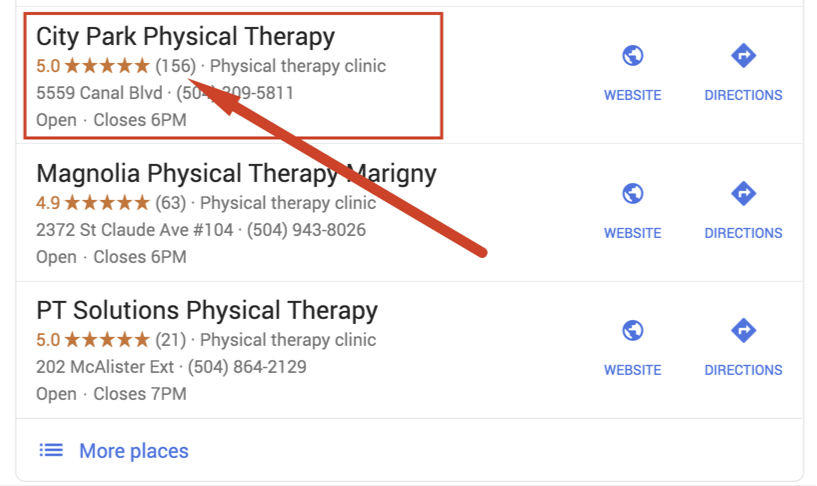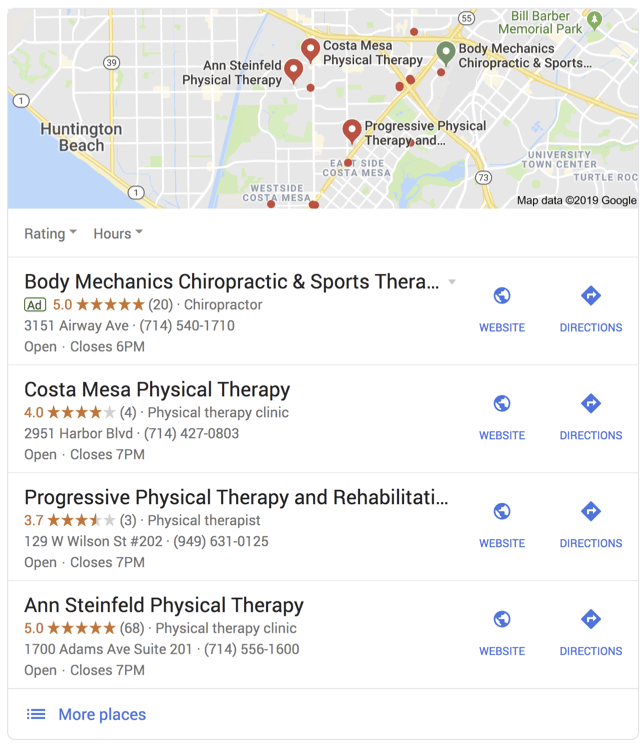Most practices owners would agree, that in today’s competitive PT market, you need a great physical therapy online marketing to win. With the myriad of online marketing options, get-rich-quick, “be a 7-figure practice” schemes, misinformation, and time constraints, practice owners are often left very confused.
While every practice has different needs, we’ve found that there are seven fundamental strategies that practices should invest in to win online today. Focus on these, and you can beat the POPTS, HOPTS, and corporations…and in most cases generate some significant new business.
1. A Physical Therapy Responsive Website

Your website is hub of your of your physical therapy online marketing strategy, but if it’s not mobile-optimized, you’re simply missing out on patients that would like to easily connect with you on their smartphones.
According to our research mobile visitors account for over 40% of visitors to physical therapy websites. This is slightly less than the research site Statista, which indicates that mobile website visitors account for approximately half of the web traffic worldwide. In the first quarter of 2019, mobile devices (excluding tablets) generated 48.71 percent of global website traffic, consistently hovering around the 50 percent mark since the beginning of 2017.
In addition, Google has made it clear that it evaluates your website for a mobile optimized version, and if the site isn’t optimized for the mobile user, it’s likely to impact your search rankings. Google states:
“Mobile-first indexing means Google predominantly uses the mobile version of the content for indexing and ranking. Historically, the index primarily used the desktop version of a page’s content when evaluating the relevance of a page to a user’s query. Since the majority of users now access Google Search with a mobile device, Googlebot primarily crawls and indexes pages with the smartphone agent going forward.”
If your site isn’t optimized for smartphone users, your search rankings are very likely to suffer.
NOTE: one tool that can be extremely useful on physical therapy websites, is chat. 79% of customers prefer live chat over email or social media for customer support due to its immediacy.
The problem with live on small PT practice websites is staffing the live chat. If you do have a request from a website viewer to chat and no one in your office is available or knows how to use a chat service, it can negatively impact your reputation.
A good solution is a chatbot. Physical therapy chatbots can proactively answer common questions and provide immediate answers to common questions and can help nurture users to the end goal of requesting an appointment. Interestingly, E-rehab.com chatbot data suggests that 1 in 10 chatbot users actually request an appointment. A chatbot should be included in your website and is an affordable way to convert more website viewers to new patients.
2. A Fast & Secure Website for Physical Therapy SEO

Search engine optimization (SEO) is the marketing practice of engineering your online brand and website content to increase your website’s chances of appearing at or near the top of search results.
According to a recent study, the number one search ranking position earns around twice as many clicks as the number two. Once you reach position six, you start receiving clicks from less than 3% of the people who see your search result listing.
More specifically, “People will have a really hard time finding your practice if you aren’t ranked near the top of search results, and you’ll miss out on the lifeblood of your practice – new patients!”
It’s been reported by many SEO authority websites that Google’s algorithm contains over 200 factors that impact a practice’s physical therapy search rankings. Some of them are out of your control and others can be addressed to improve your search rankings. Two such factors are a. having a secure website and b. the speed at which your website loads.
Here’s what Moz.com has to say on the topic:
“Google has indicated site speed (and as a result, page speed) is one of the signals used by its algorithm to rank pages. And research has shown that Google might be specifically measuring time to first byte as when it considers page speed. In addition, a slow page speed means that search engines can crawl fewer pages using their allocated crawl budget, and this could negatively affect your indexation.”
“Page speed is also important to patients that are visiting your website on their smartphones. If your web pages take a long time to load some of your website visitors will leave and search for your competition. Longer load times have also been shown to negatively affect conversions.”
Simply put, a faster-loading site will rank higher and when people click on your Google listing, they will have a better experience and are more likely to become a patient.
If page speed isn’t something you’ve considered in the past, we do recommend you consider it now.
3. Physical Therapy Reputation Management

Physical therapy reputation management has a negative connotation. Many think of reputation management as the process of limiting negative reviews, responding to negative reviews, and getting them removed from your online directory profiles (Google, Yelp, Facebook, Healthgrades, etc.).
Here at E-rehab.com, we use the term Reputation Marketing for physical therapy private practices. It’s the process of not only making sure you deal with negative reviews but also the systematic approach of capturing ratings and reviews and marketing those reviews to generate more new patients.
First, a quick reminder about why you should be building your online reputation.
- People will drive past your competition if you use this form of marketing
- It’s the second most trusted form of advertising
- 86% of consumers read this type of marketing
- 50% of consumers visit a local business after reading this type of marketing
- 79% trust this form of marketing as much as a personal referral
- 65% of patients say this marketing is moderately or very important
- 48% are willing to go out-of-network if you use this strategy
- 72% of consumers use this as the first step to choosing a doctor
Implementing a process this like this can have a profound impact on your bottom line. Making the active choice to be number one in your market, as evidenced by a large number of ratings and reviews, can generate 5, 10, even 20 or more new patients per month.
Unfortunately, many practice owners don’t understand or are unwilling to do the work to capture ratings and reviews. The good news is we’ve made the process very simple. Some of our clients are generating over 50 new patients per quarter. It’s one of the most affordable marketing opportunities for small practices and one of the only ways to compete with the large corporations and hospitals ( that will always have a bigger marketing budget than almost all small practices ).
Reputation marketing is also a marketing multiplier.
Not only does having a large quantity of ratings and reviews increase the likelihood that someone will choose your practice, they can also impact or enhance other areas of your marketing efforts. For example, if you are looking to hire a PT. We’ve heard a number of anecdotal stories from practice owners stating that they had PT employment applicants mention the practices “large number of reviews” as a factor as to why they considered applying for a job at the given practice.
Another example is the importance of Google ratings and reviews and your search rankings. As noted here in this 2018 Local Search Ranking Factors article, SEO experts agree that ratings and reviews account or approximately 15.44% of the “influence” on search rankings.
While some say it is “the way” to rank number one, this is simply not the case. Take a look at this search for “physical therapy costa mesa”.

As you can see here, the company with the most Google ratings and reviews (i.e. Ann Steinfeld Physical Therapy) does not rank number 1. Nevertheless, accumulating ratings and reviews is a positive factor that can help with your Google Maps/Three Pack ranking. It’s just not the only factor.
Nevertheless, Google ratings and reviews are indeed a marketing multiplier and physical therapy reputation marketing should be one of the top fundamentals you implement in your marketing mix.
4. Physical Therapy Content Marketing
As the saying goes, “content is king”. This means that good physical therapy content will have a positive influence on new business generation. Good physical therapy content can:
- Help capture the attention of potential new patients,
- Help define you as an authority,
- Help you rank in the search engines for various keywords, and
- Your physical therapy content can be used across a variety of online marketing channels.
Whether it’s a blog, videos, podcasts, or all of the above, your physical therapy content should be a great resource about the conditions you treat, the services you offer, and above all, make it clear that for most diagnoses, physical therapist directed care is a great first choice.
But content is also the way prospects find and evaluate your clinical expertise. Content that educates, answers questions, puts a patient/reader’s mind at ease and is generally helpful can then be followed by a call to action that can generate more initial evaluations.
Content is an important part of your search engine optimization efforts. Google loves to index new content, meaning that more frequent quality content is produced, the more likely your content is to rank for a given keyword search.
As marketing guru Gary Vaynerchuck famously said, “ We are all media companies now.”
Commit to producing high quality content on a regular basis. It’s a fundamental marketing strategy.
5. Physical Therapy Email Marketing – A System for Keeping in Touch

Once you’ve done all of the hard work of generating new patients, you also need a system to educate patients about the additional services you offer. Retention marketing or patient reactivation are the terms commonly used to market to past patients and get them back in your clinic.
Email marketing has long been a reliable channel to stay in touch with your past patients. Offering “good will” by providing quality educational information is an easy way to stay top-of-mind with your past patients.
It’s also a good idea to use other options like SMS if you have special offers like a free screening offer for past patients. Younger generations are rarely in their email inbox, preferring the speed of text messages and the social connection of messaging apps instead.
Regardless of the choice of technology, build your list and keep in touch to maximize the value of your marketing activities and the relationships you develop.
6. Really Want to Stand Out? Use Physical Therapy Videos
Video has officially taken over the Internet! According to Cisco’s Visual Networking Index, online video will account for 80 percent of all web traffic by 2019, up from 67 percent in 2014.
Ninety-five percent of people say they have watched an explainer video to learn more about a business, product, or service.
Why is video specifically a great choice for physical therapy practice owners:
- It helps build trust. People like to see the providers that will be treating them and the clinic where treatment is provided.
- You can deliver your specific message. Fact is that most scan web pages these days. With a good video, patients will watch the entire piece and will hear your entire message.
- It’s a great educational tool. Using video to in the following ways can be extremely beneficial:
- Help potential patients understand their condition,
- Share the services you offer,
- Share success stories and the experiences of other patients,
- Help patients understand what will happen during their first visit,
- Help patients understand why physical therapy should be their 1st choice
You don’t need a degree in film to produce great videos. Creating quality video is very simple with a newer smartphone and any number of apps to assist you.
If you really want to set yourself apart, physical therapy video marketing is a great opportunity. Most do nothing more than share exercises. There aren’t many (or enough) videos to describe why patients should be choosing physical therapy in the first place.
7. A Physical Therapy Social Media Presence

According to Verto Analytics, as of July 2017, we spent more than 41% of our online time on social media apps, which equates to an average of more than 25 hours per month per user. This number has stayed pretty consistent so far through 2019 as well.
Social media has its place in physical therapy marketing. The problem is that most potential new patients DO NOT look for a physical therapist on social networks. Let me illustrate this with a simple question. “If you are in need of a locksmith, an emergency dentist, a plumber, an orthopedic surgeon, or a physical therapist, would you search for someone on Facebook, Twitter, or Instagram?” Most answer this question with a resounding “NO”! First this reason, social media marketing shouldn’t be your top priority. I’m not saying that you shouldn’t do it or it isn’t important. When practice owners think of marketing, they think about generating new patients. Your social media presence might help with the retention of past patients when they follow you on Facebook, but if you want to generate new patients, posting content on Facebook, Twitter, Instagram, and/or YouTube isn’t going to generate many calls or appointment requests.
That said, advertising, or paying to get your social media posts/content in front of your local audience can be an effective way to generate more new business. This type of marketing is an advanced advertising strategy though, and requires considerable time, money, and ongoing effort. It’s not a fundamental marketing strategy for most new and small PT practice owners.
I absolutely believe that practices must have an active social media presence. However, measuring ROI can be a challenge.
Conclusion: Focus on Physical Therapy Marketing Fundamentals
There are a number of online and offline marketing options. It’s easy for practice owners to get confused, waste money on bright and shiny objects…marketing tactics that promise riches, and lose focus on the basics. Don’t make this mistake.
E-rehab.com has been helping private practice with their physical therapy online marketing and physical therapy offline marketing for over 15 years and chances are, we can help you too.
Click here to request an appointment with me or call (800) 468-5161 to learn more about how we can help.
Thanks for reading!
David Straight


Leave a Reply
You must be logged in to post a comment.